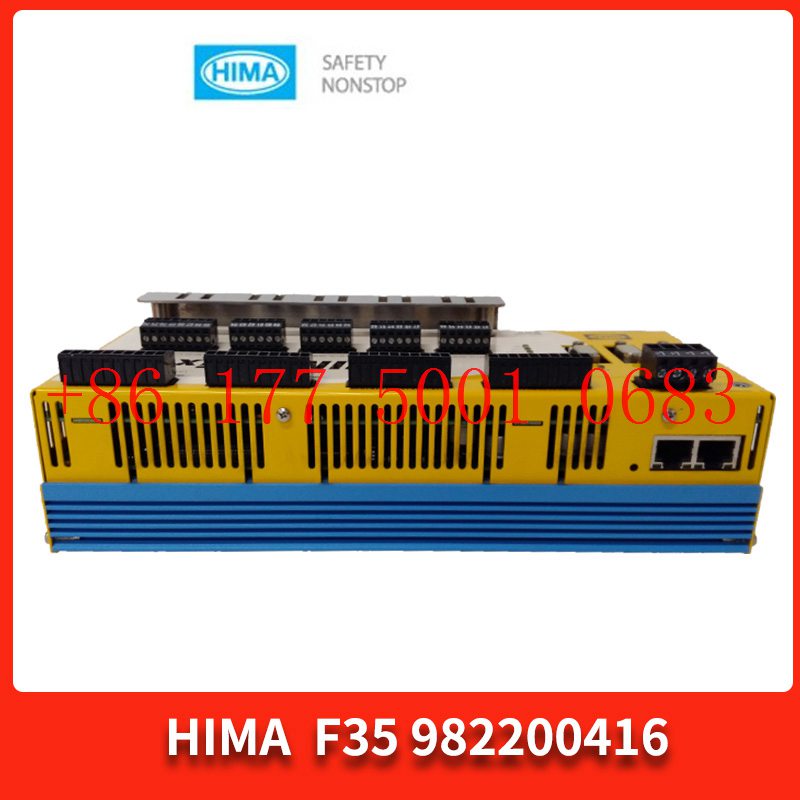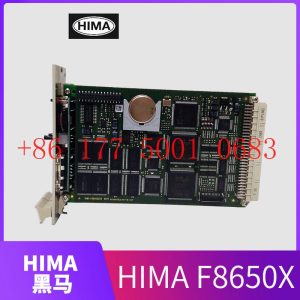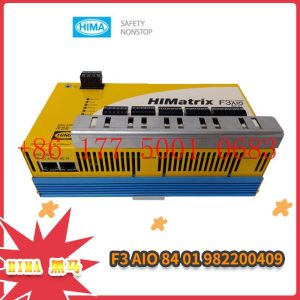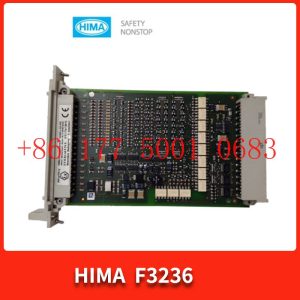Description
F7130A HIMA security module
F7130A HIMA security module
Module Clips Drive controller servo motor
Contact: Mr. Lai
Wechat:17750010683
Whats app:+86 17750010683
Skype:+86 17750010683
QQ: 3221366881
3221366881@qq.com
The term “Robot” in English comes from the Czech word “robot” and is usually translated as” forced labor “. It is very appropriate to use it to describe most robots. Most robots in the world are used to perform heavy and repetitive manufacturing tasks. They are responsible for tasks that are very difficult, dangerous, or boring for humans.
The most common type of manufacturing robot is the robotic arm. A typical robotic arm is composed of seven metal components connected by six joints. Computers rotate stepper motors connected to each joint separately to control robots (some large robotic arms use hydraulic or pneumatic systems). Unlike ordinary motors, stepper motors move precisely in increments. This allows the computer to accurately move the robotic arm, causing it to repeatedly perform identical actions. Robots use motion sensors to ensure that they move completely according to the correct amount. F7130A HIMA security module
This industrial robot with six joints is very similar to a human arm, with parts equivalent to the shoulders, elbows, and wrists. Its “shoulders” are usually installed on a fixed base structure (rather than a moving body). This type of robot has six degrees of freedom, which means it can rotate in six different directions. In contrast, a human arm has seven degrees of freedom. F7130A HIMA security module
Blob.png
The Joint of a Six Axis Industrial Robot
The function of a human arm is to move the hand to different positions. Similarly, the function of a robotic arm is to move the end effector. You can install various end effectors suitable for specific application scenarios on the machine arm. There is a common end effector that can grip and move different objects, which is a simplified version of human hands. Machine hands often have built-in pressure sensors that tell the computer the strength of the robot”s grip on a specific object. This prevents the objects in the robot”s hands from falling or being squeezed. Other end effectors also include spray lamps, drill bits, and paint sprayers.
Industrial robots are specifically designed to perform identical tasks repeatedly in a controlled environment. For example, a robot may be responsible for screwing on the lid of a peanut butter jar conveyed on an assembly line. To teach robots how to do this job, programmers will use a handheld controller to guide the robot arm through the entire movement. The robot accurately stores the sequence of actions in memory, and then repeats this set of actions every time a new can is transmitted on the assembly line.
The working principle of robots, a very detailed analysis!
The robotic arm is one of the basic components used in the manufacturing of automobiles
Most industrial robots work on car assembly lines, responsible for assembling cars. When performing a large amount of such work, robots are much more efficient than humans because they are very precise. No matter how many hours they have been working, they can still drill holes in the same position and tighten screws with the same force. Manufacturing robots also play a very important role in the computer industry. Their incredibly precise dexterity can assemble a tiny microchip.
The manufacturing and programming difficulty of robotic arms is relatively low, as they only work in a limited area. If you want to send robots to the vast external world, things become a bit complicated.
The primary challenge is to provide a feasible motion system for robots. If the robot only needs to move on flat ground, wheels or tracks are often the best choice. If the wheels and tracks are wide enough, they are also suitable for rough terrain. But robot designers often hope to use leg like structures because they have stronger adaptability. Manufacturing robots with legs also helps researchers understand the knowledge of natural kinematics, which is a beneficial practice in the field of biological research.
The legs of a robot typically move back and forth driven by hydraulic or pneumatic pistons. Each piston is connected to different leg components, just like muscles attached to different bones. It is undoubtedly a challenge to make all these pistons work together in the correct way. In the infancy stage, the human brain must figure out which muscles need to contract simultaneously to prevent falling when walking upright. Similarly, robot designers must understand the correct combination of piston movements related to walking and incorporate this information into the robot”s computer. Many mobile robots have a built-in balance system (such as a set of gyroscopes) that tells the computer when to correct the robot”s movements.
The motion of bipedal walking is inherently unstable, making it extremely difficult to achieve in the manufacturing of robots. In order to design robots that walk more steadily, designers often turn their attention to the animal kingdom, especially insects. Insects have six legs, and they often have extraordinary balance abilities and can adapt freely to many different terrains.
The term “Robot” in English comes from the Czech word “robot” and is usually translated as” forced labor “. It is very appropriate to use it to describe most robots. Most robots in the world are used to perform heavy and repetitive manufacturing tasks. They are responsible for tasks that are very difficult, dangerous, or boring for humans.
The most common type of manufacturing robot is the robotic arm. A typical robotic arm is composed of seven metal components connected by six joints. Computers rotate stepper motors connected to each joint separately to control robots (some large robotic arms use hydraulic or pneumatic systems). Unlike ordinary motors, stepper motors move precisely in increments. This allows the computer to accurately move the robotic arm, causing it to repeatedly perform identical actions. Robots use motion sensors to ensure that they move completely according to the correct amount.
This industrial robot with six joints is very similar to a human arm, with parts equivalent to the shoulders, elbows, and wrists. Its “shoulders” are usually installed on a fixed base structure (rather than a moving body). This type of robot has six degrees of freedom, which means it can rotate in six different directions. In contrast, a human arm has seven degrees of freedom.
Blob.png
The Joint of a Six Axis Industrial Robot
The function of a human arm is to move the hand to different positions. Similarly, the function of a robotic arm is to move the end effector. You can install various end effectors suitable for specific application scenarios on the machine arm. There is a common end effector that can grip and move different objects, which is a simplified version of human hands. Machine hands often have built-in pressure sensors that tell the computer the strength of the robot”s grip on a specific object. This prevents the objects in the robot”s hands from falling or being squeezed. Other end effectors also include spray lamps, drill bits, and paint sprayers.
Industrial robots are specifically designed to perform identical tasks repeatedly in a controlled environment. For example, a robot may be responsible for screwing on the lid of a peanut butter jar conveyed on an assembly line. To teach robots how to do this job, programmers will use a handheld controller to guide the robot arm through the entire movement. The robot accurately stores the sequence of actions in memory, and then repeats this set of actions every time a new can is transmitted on the assembly line.
The working principle of robots, a very detailed analysis!
The robotic arm is one of the basic components used in the manufacturing of automobiles
Most industrial robots work on car assembly lines, responsible for assembling cars. When performing a large amount of such work, robots are much more efficient than humans because they are very precise. No matter how many hours they have been working, they can still drill holes in the same position and tighten screws with the same force. Manufacturing robots also play a very important role in the computer industry. Their incredibly precise dexterity can assemble a tiny microchip.
The manufacturing and programming difficulty of robotic arms is relatively low, as they only work in a limited area. If you want to send robots to the vast external world, things become a bit complicated.
The primary challenge is to provide a feasible motion system for robots. If the robot only needs to move on flat ground, wheels or tracks are often the best choice. If the wheels and tracks are wide enough, they are also suitable for rough terrain. But robot designers often hope to use leg like structures because they have stronger adaptability. Manufacturing robots with legs also helps researchers understand the knowledge of natural kinematics, which is a beneficial practice in the field of biological research.
The legs of a robot typically move back and forth driven by hydraulic or pneumatic pistons. Each piston is connected to different leg components, just like muscles attached to different bones. It is undoubtedly a challenge to make all these pistons work together in the correct way. In the infancy stage, the human brain must figure out which muscles need to contract simultaneously to prevent falling when walking upright. Similarly, robot designers must understand the correct combination of piston movements related to walking and incorporate this information into the robot”s computer. Many mobile robots have a built-in balance system (such as a set of gyroscopes) that tells the computer when to correct the robot”s movements.
The motion of bipedal walking is inherently unstable, making it extremely difficult to achieve in the manufacturing of robots. In order to design robots that walk more steadily, designers often turn their attention to the animal kingdom, especially insects. Insects have six legs, and they often have extraordinary balance abilities and can adapt freely to many different terrains.
When selecting industrial robots, we often encounter the selection of industrial robot loads. How to choose the appropriate load? This problem often troubles us. Today, I will explain to you how to choose the appropriate load and the appropriate fixture size range.
The limitations of industrial robots on tools
Permissible portable weight
Maximum allowable static load torque
Permissible maximum moment of inertia
There are three limitations, and when designing tools, the wrist load must be controlled within the allowable range.
1. Portable weight
The installation load on the front end of the robot”s wrist must be controlled within the allowable portable weight.
Dry goods: the connection between the load and tools of industrial robots
Example
The load weight of the handling robot must consider the total weight of the gripper and workpiece.
2. Static load torque
Use a diagram to represent the limit range of the static load torque mentioned above, which is the torque diagram below. After determining the weight and center of gravity of the tool, first use this torque diagram and take a brief look to confirm. Calculate and confirm next to the limit line. Please observe the situation where the load is getting lighter and the scope is getting wider.
Dry goods: the connection between the load and tools of industrial robots
Static load torque diagram
3. Inertia torque
Installation load at the front end of the robot wrist: According to the weight and center of gravity position, the calculated inertia torque must be controlled within the allowable maximum inertia torque.
Dry goods: the connection between the load and tools of industrial robots
Example
[Calculation Example]: Taking MZ07-01 as an example, calculate the inertia moment when a load of 5 [kg] is 0.1 [m] away from the 6th axis rotation center.
(Moment of Inertia)=(Load Weight [kg]) X (Distance to Center [m])?
=5 x 0.1?
=0.05 [kg. m?]
The torque is 5kg x 9.8 x 0.1m=4.9 [N.m]. Referring to the torque diagram, it can be seen that the calculated inertia torque of 0.05 [kg. m?] is below the limit value.
Use a diagram to represent the limit range of the inertia moment mentioned above, which is shown in the following figure. Please note that according to the static load torque, the limit value will change. After determining the weight and center of gravity of the tool, first use this diagram and confirm the lines on the diagram.
Dry goods: the connection between the load and tools of industrial robots
Tool installation
Operate the robot to a safe installation tool posture. When installing tools, it is not necessary to face them directly above or below.
Dry goods: the connection between the load and tools of industrial robots
Installation diagram
Dry goods: the connection between the load and tools of industrial robots
Flange diagram
Attention:
The bolt depth of the tool and end effector mounting bolts must be less than the screw depth of the mounting surface. If the bolt depth exceeds the screw depth, there is a possibility of damaging the wrist.
PXI-2533
CROO-9104
CRLO-9012
CRKO-9104
CRJO-9042
CRJO-9022
CRIO-P048
CRIO-P004
CRIO-O104
CRIO-O022
cRIO-FRC
CRIO-9Q04
CRIO-9P33
CRIO-9O33
cRIO-9958
cRIO-9939
cRIO-9937
cRIO-9803
cRIO-9148
cRIO-9116
cRIO-9114
cRIO-9113
cRIO-9112
cRIO-9111
cRIO-9103
cRIO-9102
cRIO-9101
CRIO-90T8
CRIO-90E2
cRIO-9082
cRIO-9081
cRIO-9076
cRIO-9075
cRIO-9074
cRIO-9073
cRIO-9068
cRIO-9067
cRIO-9066
cRIO-9065
cRIO-9064
cRIO-9063
cRIO-9058
cRIO-9057
cRIO-9056
cRIO-9055
cRIO-9054
cRIO-9053
CRIO-904W
CRIO-904Q
cRIO-9049
cRIO-9048
cRIO-9047
cRIO-9046
cRIO-9045
cRIO-9043
cRIO-9042
cRIO-9041
cRIO-9040
cRIO-9039
cRIO-9038
cRIO-9037
cRIO-9036
cRIO-9035
cRIO-9034
cRIO-9033
cRIO-9032
cRIO-9031
cRIO-9030
cRIO-9025
cRIO-9024
cRIO-9023
cRIO-9022
cRIO-9014
cRIO-9012
CRIO-900R
cRIO-9004
cRIO-9002
CRII-9104
CRII-9004
cRI0-9118
cRI0-9116
cRI0-9113
cRI0-9112
cRI0-9104
cRI0-9103
cRI0-9025
CRAQ-9179
GPIB-140A 186135G-01
NI-9853
1.Has been engaged in industrial control industry for a long time, with a large number of inventories.
2.Industry leading, price advantage, quality assurance
3.Diversified models and products, and all kinds of rare and discontinued products
4.15 days free replacement for quality problems
ABB — AC 800M controller, Bailey, PM866 controller, IGCT silicon controlled 5SHY 3BHB01 3BHE00 3HNA00 DSQC series
BENTLY — 3500 system/proximitor, front and rear card, sensor, probe, cable 3500/20 3500/61 3500/05-01-02-00-001 3500/40M 176449-01 3500/22M 138607-01
Emerson — modbus card, power panel, controller, power supply, base, power module, switch 1C31,5X00, CE400, A6500-UM, SE3008,1B300,1X00,
EPRO — PR6423 PR6424 PR6425 PR6426 PR9376 PR9268 Data acquisition module, probe, speed sensor, vibration sensor
FOXBORO — FCP270 FCP280 FCM10EF FBM207 P0914TD CP40B FBI10E FBM02 FBM202 FBM207B P0400HE Thermal resistance input/output module, power module, communication module, cable, controller, switch
GE —- IS200/215/220/230/420 DS200/215 IC693/695/697/698 VMICPCI VMIVME 369-HI-R-M-0-0-E 469 module, air switch, I/O module, display, CPU module, power module, converter, CPU board, Ethernet module, integrated protection device, power module, gas turbine card
HIMA — F3 AIO 8/4 01 F3231 F8627X Z7116 F8621A 984862160 F3236 F6217 F7553 DI module, processor module, AI card, pulse encoder
Honeywell — Secure digital output card, program module, analog input card, CPU module, FIM card
MOOG — D136-001-007 Servo valve, controller, module
NI — SCXI-1100 PCI – PXIE – PCIE – SBRIO – CFP-AO-210 USB-6525 Information Acquisition Card, PXI Module, Card
Westinghouse — RTD thermal resistance input module, AI/AO/DI/DO module, power module, control module, base module
Woodward — 9907-164 5466-258 8200-1300 9907-149 9907-838 EASYGEN-3500-5/P2 8440-2145 Regulator, module, controller, governor
YOKOGAWA – Servo module, control cabinet node unit
Main products:
PLC, DCS, CPU module, communication module, input/output module (AI/AO/DI/DO), power module, silicon controlled module, terminal module, PXI module, servo drive, servo motor, industrial display screen, industrial keyboard, controller, encoder, regulator, sensor, I/O board, counting board, optical fiber interface board, acquisition card, gas turbine card, FIM card and other automatic spare parts







